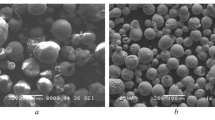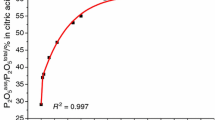Abstract
As the main raw material for ceramics and coatings, black talc contains high contents of organic carbon and quartz, which deteriorates the whiteness and purity of calcined talc. In this work, calcined talc powders with high whiteness and purity have been prepared by the milling and reactive calcination of black talc with magnesium precursors. Black talc and calcined powders were analyzed by the crystal and chemical compositions, particle size distribution, thermal decomposition, and microstructural observation. The Gibbs free energy of solid reactions was calculated to evaluate the product phases in the reactive calcination. The milling of black talc released organic carbon and colored minerals, which were mostly removed in the magnetic separation and calcination, thus greatly increasing the whiteness of calcined powders. The protoenstatite phase in the calcined powders is continuously enhanced with increasing calcination temperature, whereas the total amount of quartz and cristobalite are the opposite. In the calcination process, magnesium precursors reacted with the quartz phase to produce the protoenstatite and forsterite phases, resulting in the reduction of the quartz phase and purification of the calcined powders. With the addition of 23% nano-MgO, the powder mixture calcined at 1250 °C has a protoenstatite and forsterite content of 84.5% and 14.4%, respectively, and the quartz and cristobalite amount is as low as 1.1%, with a powder whiteness of 93%. Compared to the present physical purifications, the combination of milling and reactive calcination greatly increases the grade of calcined talc powders and extends the commercial applications of black talc.














Similar content being viewed by others
References
Zhang M, Hui Q, Lou XJ, Redfern SA, Salje EK, Tarantino SC. Dehydroxylation, proton migration, and structural changes in heated talc: an infrared spectroscopic study. Am Mineral. 2006. https://doi.org/10.2138/am.2006.1945.
Agarwal R, Paul AS, Aggarwal AN, Gupta D, Jindal SK. A randomized controlled trial of the efficacy of cosmetic talc compared with iodopovidone for chemical pleurodesis. Respirology. 2011. https://doi.org/10.1111/j.1440-1843.2011.01999.x.
Yu Y, Xue G, Gu C, Lou J, Li S. Preparation of chitosan modified talc and its application in high filler content paper. J Appl Polym Sci. 2013. https://doi.org/10.1002/app.38992.
Li C, Wang R, Xu H, Lu X, Konishi H, He K. Interstratification of graphene-like carbon layers within black talc from Southeastern China: implications to sedimentary talc formation. Am Mineral. 2016. https://doi.org/10.2138/am-2016-5600.
Filippov L, Joussemet R, Irannajad M, Houot R, Thomas A. An approach of the whiteness quantification of crushed and floated talc concentrate. Powder Technol. 1999. https://doi.org/10.1016/S0032-5910(99)00124-2.
Ptáček P, Lang K, Šoukal F, Opravil T, Bartoníčková E, Tvrdík L. Preparation and properties of enstatite ceramic foam from talc. J Euro Ceram Soc. 2014. https://doi.org/10.1016/j.jeurceramsoc.2013.08.007.
Meng Y, Xie W, Wu H, Tariq SM, Yang H. Evolution of black talc upon thermal treatment. Minerals. 2022. https://doi.org/10.3390/min12020155.
Xu FF, Li JH, Wang YC. Whitening and phase variation of black talc by calcination from Guangfeng area Jiangxi province. Non-Met Mines. 2010. https://doi.org/10.3969/j.issn.1000-8098.2010.06.005.
Barani K, Aghazadeh V. Removal of impurities from talc ore by leaching method. Chem Technol Metall. 2018. https://search.ebscohost.com/login.aspx?direct=true&db=asx&AN=128048981&site=eds-live.
Castleman BA, van der Merwe EM, Doucet FJ. Thermochemical purification of talc with ammonium sulphate as chemical additive. Miner Eng. 2021. https://doi.org/10.1016/j.mineng.2021.106815.
Ann Bazar J, Rahimi M, Fathinia S, Jafari M, Chipakwe V, Chehreh CS. Talc flotation—an overview. Minerals. 2021. https://doi.org/10.3390/min11070662.
Hu ZG. Experimental study on improving grade of talc ore by floatation. Adv Mater Res. 2013. https://doi.org/10.4028/www.scientific.net/AMR.826.42.
Feng B, Peng J, Guo W, Zhang W, Ai G, Wang H. The effect of changes in pH on the depression of talc by chitosan and the associated mechanisms. Powder Technol. 2018. https://doi.org/10.1016/j.powtec.2017.11.005.
Liu C, Zhang W, Song S, Li H. A novel method to improve carboxymethyl cellulose performance in the flotation of talc. Miner Eng. 2019. https://doi.org/10.1016/j.mineng.2018.11.003.
Baba AA, Akinribido JP, Raji MA. Upgrading of a Nigerian vermiculite-phillipsite rich talc ore by flotation-cum-acid leaching routes for industrial applications. Mater Circ Econ. 2021. https://doi.org/10.1007/s42824-021-00018-2.
Valášková M, Blahůšková V, Martaus A, Študentová S, Vallová S, Tokarský J. Effect of talc in mixtures with fly ash on sintering crystalline phases and porosity of mullite-cordierite ceramics. Minerals. 2021. https://doi.org/10.3390/min11020154.
Dzulkafli HH, Ahmad F, Ullah S, Hussain P, Mamat O, Megat-Yusoff PSM. Effects of talc on fire retarding, thermal degradation and water resistance of intumescent coating. Appl Clay Sci. 2017. https://doi.org/10.1016/j.clay.2017.06.013.
Yalçin H, Bozkaya Ö. Mineralogy and geochemistry of Paleocene ultramafic and sedimentary-hosted talc deposits in the southern part of the Sivas Basin, Turkey. Clays Clay Miner. 2006. https://doi.org/10.1346/CCMN.2006.0540305.
Muhammad N, Ahmad W, Khan M, Salman M, Ali A. Purification and removal of hematite from talc by acid leaching assisted by chlorination techniques. Min Metall Explor. 2021. https://doi.org/10.1007/s42461-021-00468-x.
Wesołowski M. Thermal decomposition of talc: a review. Thermochim Acta. 1984. https://doi.org/10.1016/0040-6031(84)87165-8.
Tironi A, Trezza MA, Scian AN, Irassar EF. Thermal analysis to assess pozzolanic activity of calcined kaolinitic clays. J Therm Anal Calorim. 2014. https://doi.org/10.1007/s10973-014-3816-1.
Okada K, Ikawa F, Isobe T, Kameshima Y, Nakajima A. Low temperature preparation and machinability of porous ceramics from talc and foamed glass particles. J Euro Ceram Soc. 2009. https://doi.org/10.1016/j.jeurceramsoc.2008.07.055.
Wang L, Hu XZ, Wang ZH. Study on the influential factors and whitening mechanism of mineral whiteness. Acta Petrol Sin. 2019. https://doi.org/10.18654/1000-0569/2019.01.10.
Mahadi MI, Palaniandy S. Mechanochemical effect of dolomitic talc during fine grinding process in mortar grinder. Int J Miner Process. 2010. https://doi.org/10.1016/j.minpro.2010.02.008.
Li BY, Li AC, Zhao S, Meyers MA. Amorphization by mechanical deformation. Mater Sci Eng R. 2022. https://doi.org/10.1016/j.mser.2022.100673.
Aglietti EF. The effect of dry grinding on the structure of talc. Appl Clay Sci. 1994. https://doi.org/10.1016/0169-1317(94)90033-7.
Wu XZ, Deng XY, Li JB, Chen RL, Zhu SJ. The cristobalite transition of α-quartz. 2009 China International Symposium on Advanced Materials and Technology. 2009.
Pagliari L, Dapiaggi M, Pavese A, Francescon F. A kinetic study of the quartz-cristobalite phase transition. J Euro Ceram Soc. 2013. https://doi.org/10.1016/j.jeurceramsoc.2013.06.014.
Smyth JR. Protoenstatite: a crystal-structure refinement at 1100 °C. Z Krist Cryst Mater. 1971. https://doi.org/10.1524/zkri.1971.134.3-4.262.
Belgacem K, Llewellyn P, NNahdi K, Trabelsi-Ayadi M. Thermal behaviour study of the talc. Optoelectron Adv Materi Rapid Commun. 2008. https://www.researchgate.net/publication/285810912.
Ye DL, Hu JH. Practical inorganic thermodynamics databook. 2nd ed. Beijing: Metallurgical Industry Press; 2002.
Chen LG, Ye GT, Zhou WH, Dijkmans J, Sels B, Malfliet A, Guo MX. Influence of MgO precursors on mechanically activated forsterite synthesis. Ceram Int. 2015. https://doi.org/10.1016/j.ceramint.2015.06.096.
Chen Y. Research on the synthesis of forsterite and its application, PhD dissertation, Northeastern University, Shenyang. 2014. https://kns.cnki.net/KCMS/detail/detail.aspx?dbname=CDFDLAST2015&filename=1015559748.nh.
Green J. Calcination of precipitated Mg(OH)2 to active MgO in the production of refractory and chemical grade MgO. J Mater Sci. 1983. https://doi.org/10.1007/BF00745561.
Chen SY. Structure and properties of periclase-forsterite refractories for regenerator of glass furnace. Master dissertation, Wuhan University of Science and Technology, Wuhan. 2018. https://kns.cnki.net/KCMS/detail/detail.aspx?dbname=CMFD201802&filename=1018191905.nh.
Hubbe MA, Gill RA. Fillers for papermaking: a review of their properties, usage practices, and their mechanistic role. BioResources. 2016. https://doi.org/10.15376/biores.11.1.2886-2963.
Acknowledgements
This research work is financially supported by the National Natural Science Foundation of China (Grant No. 52060020), Natural Science Foundation of Jiangxi Province (Grant No. 2020BABL204013) and Postgraduate Creative Fund of Jiangxi Province (Grant No. YC2021-S656). The authors are grateful to Mr. B. Pan in providing black talc mineral. We thank International Science Editing (http://www.internationalscienceediting.com) for editing this manuscript.
Author information
Authors and Affiliations
Contributions
DW: Experiments, Writing—original draft. JL: Supervision, Conceptualization, Writing—review and revision. BX: Data analysis. ZL: Theoretical analysis. KG: Experiment procedure.
Corresponding author
Additional information
Publisher's Note
Springer Nature remains neutral with regard to jurisdictional claims in published maps and institutional affiliations.
Rights and permissions
Springer Nature or its licensor (e.g. a society or other partner) holds exclusive rights to this article under a publishing agreement with the author(s) or other rightsholder(s); author self-archiving of the accepted manuscript version of this article is solely governed by the terms of such publishing agreement and applicable law.
About this article
Cite this article
Wang, D., Lu, J., Xie, B. et al. Whitening and purification of calcined talc powders from black talc by the milling and reactive calcination with magnesium precursors. J Therm Anal Calorim 148, 11619–11628 (2023). https://doi.org/10.1007/s10973-023-12457-x
Received:
Accepted:
Published:
Issue Date:
DOI: https://doi.org/10.1007/s10973-023-12457-x




